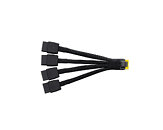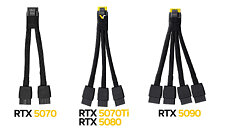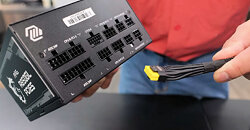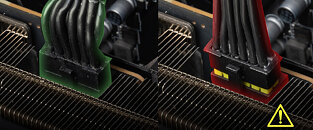T0@st
News Editor
- Joined
- Mar 7, 2023
- Messages
- 3,063 (3.89/day)
- Location
- South East, UK
| System Name | The TPU Typewriter |
|---|---|
| Processor | AMD Ryzen 5 5600 (non-X) |
| Motherboard | GIGABYTE B550M DS3H Micro ATX |
| Cooling | DeepCool AS500 |
| Memory | Kingston Fury Renegade RGB 32 GB (2 x 16 GB) DDR4-3600 CL16 |
| Video Card(s) | PowerColor Radeon RX 7800 XT 16 GB Hellhound OC |
| Storage | Samsung 980 Pro 1 TB M.2-2280 PCIe 4.0 X4 NVME SSD |
| Display(s) | Lenovo Legion Y27q-20 27" QHD IPS monitor |
| Case | GameMax Spark M-ATX (re-badged Jonsbo D30) |
| Audio Device(s) | FiiO K7 Desktop DAC/Amp + Philips Fidelio X3 headphones, or ARTTI T10 Planar IEMs |
| Power Supply | ADATA XPG CORE Reactor 650 W 80+ Gold ATX |
| Mouse | Roccat Kone Pro Air |
| Keyboard | Cooler Master MasterKeys Pro L |
| Software | Windows 10 64-bit Home Edition |
MSI is preparing a new selection of yellow-tipped 16-pin power adapters—as reported by VideoCardz earlier today—for inclusion with certain GeForce RX 50 series "Blackwell" GPU-based graphics card models. An official announcement has not been released—regarding the latest color coding for power connectors—but new product photos have appeared on the MSI website. The yellow sections provide a clear "visual guide" when hooking the relevant adapter up to a graphics card—full insertion is achieved when the yellow tip is fully obscured by its surroundings. MSI's latest image uploads indicate that dual 8-pin to single 16-pin adapters will likely be bundled with MSI's GeForce RTX 5070 models. The RTX 5070 Ti and 5080 product tiers will be getting three 8-pin ended adapters. A very busy-looking 4-way splitter is seemingly reserved for flagship GeForce RTX 5090 cards.
The MAG GL PSU series debuted back in 2023, featuring a similarly-tinted "dual color" safety measure—based on customer and community feedback. At the time, MSI stated that it had reacted to: "reported cases of power supply connectors being burnt when paired with high-end graphics cards. We've identified the main reason: the connectors not being plugged in properly and the connector pins suffering from fall outs. With this new cable, we successfully tackle both issues head-on." Manufacturers have continued to release new products that utilize the "problematic" 12VHPWR standard, even years after the introduction of a successor: 12V-2x6. NVIDIA and several of its board partners are reported to be sticking with the first iteration PCIe Gen 5 16-pin connector for upcoming GeForce RTX 50-series graphics cards. The TechPowerUp team inspected ZOTAC's new 12WHPWR "Safety Light" feature at the recently concluded CES trade event—a visual warning will be displayed in the event of a connection problem being detected.




View at TechPowerUp Main Site | Source
The MAG GL PSU series debuted back in 2023, featuring a similarly-tinted "dual color" safety measure—based on customer and community feedback. At the time, MSI stated that it had reacted to: "reported cases of power supply connectors being burnt when paired with high-end graphics cards. We've identified the main reason: the connectors not being plugged in properly and the connector pins suffering from fall outs. With this new cable, we successfully tackle both issues head-on." Manufacturers have continued to release new products that utilize the "problematic" 12VHPWR standard, even years after the introduction of a successor: 12V-2x6. NVIDIA and several of its board partners are reported to be sticking with the first iteration PCIe Gen 5 16-pin connector for upcoming GeForce RTX 50-series graphics cards. The TechPowerUp team inspected ZOTAC's new 12WHPWR "Safety Light" feature at the recently concluded CES trade event—a visual warning will be displayed in the event of a connection problem being detected.




View at TechPowerUp Main Site | Source






